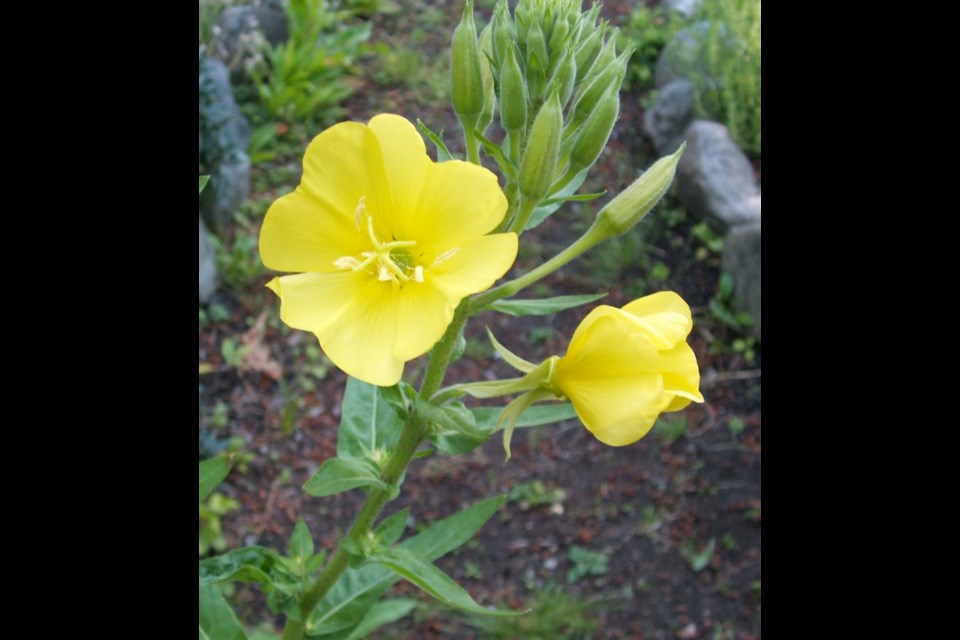Dear Helen: Can you identify a tall, upright, single-stemmed plant that has appeared in my garden? It has spikes of large, silky, yellow flowers.
S.W.
The plant in your photo is common evening primrose (Oenothera biennis). It can grow up to 150 cm tall, though the plants that appear regularly in my garden are almost always between 90 and 120 cm high. This is a North American native plant that has become widely naturalized.
Dear Helen: I have never found growing zucchini to be a challenge until this year. My healthy plant has set plenty of fruit, but they turn yellow instead of maturing. The plant is growing in good soil that is kept adequately moistened.
A.F.
This is a common issue with zucchini. It indicates some stressor causing incomplete fertilization of female flowers. When that happens, the tiny fruit-to-be located behind the flower starts to develop and then slowly withers.
The stressor(s) can be poor or dry soil, a lack of pollinating insects, or uncongenial weather conditions.
This year, the most probable cause of poor fruit development is the weather. The rainfall and cool temperatures through May and June, and even early July, will have affected both the quality of the pollen and its ability to travel freely into the centres of the female blooms for successful fertilization of the ovules within a flower’s ovary.
As the weather settles in to a more summer-like pattern, your plant will likely become more productive. Meanwhile, if you’d like young, vigorous plants for a zucchini harvest in late summer and well into autumn, sow a few seeds now, outdoors or in. If you seed indoors, transplant as soon as sturdy little bushes have formed.
Dear Helen: I’ve noticed “pea shoots” have become popular as salad greens. Can any type of pea be used to grow the shoots?
B.G.
The greens of all kinds of peas can be used for growing shoots, but greens sold as pea shoots are usually snow peas. Sugar snap peas are very alike botanically and will yield similar greens.
This spring I found out, quite accidentally, how tasty snow pea shoots could be. When I came to seeding snow peas in March, I decided not to continue growing one of the varieties I had. I emptied the rejected packet onto a compost heap, which was later turned over, mixed up well, topped with finished compost and good garden soil, and planted with a winter squash.
While the squash plant settled in and before it began to expand, the snow peas sprouted. As they pushed out greens, I snacked on them and invited visitors in the garden to do the same. We were all impressed with the fresh, sweet taste.
Because snow peas will regrow as long as they are not cut too low down on the stems, it is possible to enjoy the shoots for a couple of cuttings before letting them develop into pod-bearing vines.
To grow pea shoots, take care to use seeds untreated with fungicides or other chemicals. For the best flavour, cut the shoots when they are around five cm long, right before consuming them. Longer, older stems can be tough.
In winter, grow pea shoots in pots at the brightest possible window.
Dear Helen: Can you think of a reason for my bulb onions (Kelsae) to topple over and die before they began forming bulbs? I pulled a few up, to find their bases had gone squishy. Does this mean my leeks will die too?
S.D.
Onion maggots most likely caused the ruination of your plants. Adult flies emerge in early spring, from pupae over-wintered in the soil, to lay eggs at the bases of target plants. The eggs hatch into larvae (maggots) that burrow into the plant bases and feed there, causing the bases and any developing bulbs to turn into mush. The plants fall over and die. Another set of adults appears in early summer.
This pest is similar in appearance and life cycle to the cabbage maggot, which burrows into the roots of cabbage family plants to weaken or kill them.
Leeks and other onion family plants are rarely targeted by the onion maggot fly, though I have heard of it happening. The only sure way to protect onions is with insect netting or floating row cover secured as a barrier over plantings.



